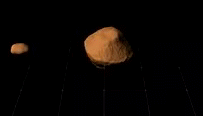(66391) 1999 KW4
|
Simulated animation of 1999 KW4's rotation and moon. | |
| Discovery | |
|---|---|
| Discovered by | LINEAR |
| Discovery date | 20 May 1999 |
| Designations | |
| none | |
|
Aten asteroid, Mercury-crosser asteroid, Venus-crosser asteroid | |
| Orbital characteristics[1] | |
| Epoch 13 January 2016 (JD 2457400.5) | |
| Uncertainty parameter 0 | |
| Observation arc | 6238 days (17.08 yr) |
| Aphelion | 1.0845 AU (162.24 Gm) |
| Perihelion | 0.20009 AU (29.933 Gm) |
| 0.64228 AU (96.084 Gm) | |
| Eccentricity | 0.68847 |
| 0.51 yr (188.0 d) | |
Average orbital speed | 37.16 km/s |
| 290.088° | |
| 1.9148°/day | |
| Inclination | 38.884° |
| 244.919° | |
| 192.619° | |
| Earth MOID | 0.0124542 AU (1.86312 Gm) |
| Jupiter MOID | 4.22849 AU (632.573 Gm) |
| Physical characteristics | |
| Dimensions | 1.5 x 1.5 x 1.34 km (primary) |
Mean radius | 0.6585 ± 0.02 km |
| Mass | 2.4×1012 kg |
Mean density | 2.0 g/cm³ |
Equatorial surface gravity | 0–0.000 36 m/s² (variable) |
Equatorial escape velocity | 0.000 72 km/s |
| 2.7645 h (0.11519 d) | |
| 0.15 | |
| Temperature | 250–600 K |
| 16.5 | |
|
| |
(66391) 1999 KW4 (also written (66391) 1999 KW4) is an Aten and Mercury-crossing binary asteroid[2] discovered by LINEAR in 1999.
1999 KW4 has a moon orbiting it. The moon, designated S/2001 (66391) 1 or "1999 KW4 Beta", is ~360 m in diameter, and orbits 1999 KW4 'Alpha' in 0.758 d (16 hours) at a distance of 2.6 km. The presence of a companion was suggested by photometric observations made June 19–27, 2000 by Petr Pravec and Lenka Šarounová at Observatoř Ondřejov (Ondřejov Observatory) and was confirmed by radar observations from Arecibo Observatory from May 21–23, 2001 by Lance A. M. Benner, Steven J. Ostro, Jon D. Giorgini, Raymond F. Jurgens, Jean-Luc Margot and Michael C. Nolan, announced on May 23, 2001.[2]
The shapes of the two bodies and their dynamics are complex.[3] Among other bizarre properties, the equatorial regions of Alpha are very close to breakup: raising a particle a meter above the surface would put it into orbit. As seen in the image at above right, the gravitational effects between the moon and the asteroid create a gigantic mountain extending in the equatorial plane around the entire asteroid.
On May 25, 2036, it will pass 0.0155 AU (2,320,000 km; 1,440,000 mi) from Earth.[1]

See also
| Wikimedia Commons has media related to (66391) 1999 KW4. |
References
- 1 2 "JPL Close-Approach Data: 66391 (1999 KW4)" (2013-05-09 last obs (arc=14.9 yr)). Retrieved 6 April 2016.
- 1 2 Johnston, Robert. "(66391) 1999 KW4". johnstonsarchive.net. Retrieved 29 May 2015.
- ↑ NASA Jet Propulsion Laboratory Asteroid Radar Research, retrieved May 3, 2007
- Johnston, Wm. Robert, ed. (66391) 1999 KW4 January 7, 2007, retrieved May 3, 2007
- Margot, Jean-Luc, Radar observations of 1999 KW4 November 1999, retrieved July 2016
